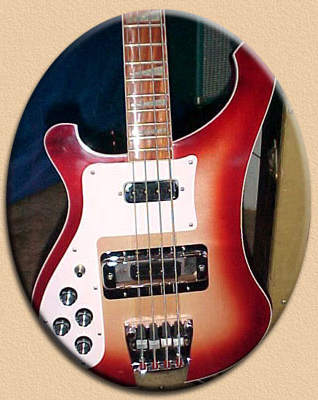| Buying Your First Rickenbacker... |
Buying your first Rickenbacker is a day to remember for the rest of your life.
I recently got hold of my first Rickenbacker bass. It's a leftie 1995 4003 Fireglo ...and I love it!
I found it in a shop on London's famous Denmark Street, a street that has nothing else on it other
than guitar shops. Heaven!
I had travelled to London with the specific intention of buying a bass and having a few drinks
with an old friend (who happens to be the proud owner of a 1978 4001).
We checked out several shops and found a few interesting possibilities, but by this point found
ourselves getting a bit over excited by the sight of so many vintage and drop-dead gorgeous
instruments. One quick trip to the pub to calm our nerves and we headed back to play.
My bass was sitting at the back of a left handed section in one of the last shops we visited and
it immediately caught my eye. The tell-tale headstock and the legendary curved name plate
sang out to me across the sea of guitar necks.
From the first note played I knew that I would look no further. While my friend was enquiring as
to what case came with it, I was playing away and grinning at the beautiful, warm, rich tones the instrument
produced. Fender might have invented the bass, but Rickenbacker perfected it!
One of the things that struck us both was the shear lack of wear on the guitar. The finish
didn't have a mark on it and looked like it had never been played in its six years since manufacture (what a crime).
Not that I'm complaining.
Despite being right handed, my friend had to have a play. 'It's just like my 4001... just upside down and a different
finish,' he exclaimed with a big smile across his face. And he was right. When we got back to his flat we compared
the two. We couldn't tell them apart from sound alone.
This is the one thing that marks the 4000 series as a great buy. The standard and quality hasn't wavered an inch
through the years of production. Unlike all other guitar manufacturers, Rickenbacker have never had a bad year.
Whatever your purchase, you know it's going to be a great instrument.
Tips
So life with a 4003? Well I have had it for two months now. One of the things to watch for is not to loosen the mute
nuts too far. The plate dropped off the bottom of mine and the spring loaded nature prevented easy retrieval. I ended
up getting a bent piece of wire to support the plate under the foam so the bolt could be guided back into the
threaded hole. I now keep this piece of wire in my guitar case for future use, should I be so careless!
The action was a little too high for my playing, but this is quickly sorted. Two threaded bolts adjust the height, although
you might need to shave some of the foam off the bottom of the mute to prevent it from interfering.
What I did was to carefully remove the foam altogether, measure the string height, set the strings to fit my preferred
playing style and then re-measure the string height. Then, with a white chinagraph pencil (the sort used by dressmakers and to write on mixing desks in the studio) draw a line around the bottom of the foam. With a very sharp craft knife, simply cut
away the excess, apply a new piece of double sided sticky tape and refit into the mute with a pair of tweezers.
Job done!
Recommendations
Get one and smile a lot. I do every time I open the case!
~ Richard J. Hinton ~
|
|

